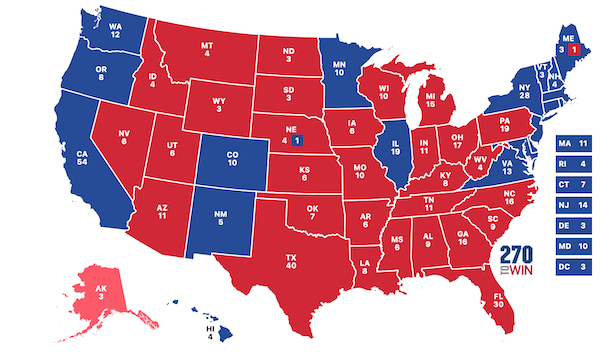|
Trump Wins Return Trip to the White House
November 11, 2024
Voters have again elected Donald Trump to be President of the United States. He will be the second President to serve nonconsecutive terms (following Grover Cleveland, who won election in 1884 and 1892 but lost in the intervening election). Trump won a strong majority of the electoral votes on offer. It was clear in the early-morning hours of the day after Election Day that he had passed the needed number of 270, but it took nearly a week to count all of the votes in a handful of states and so the total was 312 for Trump and 226 for his opponent, Vice-president Kamala Harris. Trump, for the first time in three attempts, won the popular vote as well. Harris was aiming to become the first President of South Asian descent (through her mother) and (through her father) the second Black President. (The first, Barack Obama, was elected in 2008 and re-elected in 2012.) Harris was by no means the first woman to run for President, on a minor or a major political party ticket. Nor was she the first woman to serve as a major party's general election nominee: that title went to Hillary Clinton, who was the Democratic nominee in 2016. (She lost that election to Trump.) It was a straightforward path to the Republican nomination for Trump, who after the 2020 election, maintained his stature as the party standard-bearer and, in early 2024, won every Republican Party political primary and caucus. In so doing, Trump became the first Republican candidate ever to be nominated for the presidency three times in succession. Richard Nixon won the Republican nomination three times but in nonconsecutive election cycles: He was the losing candidate to John F. Kennedy in 1960 and then won the presidency in 1968 and re-election four years later. Only four other major party candidates have won the nomination three times: Thomas Jefferson (for the Democratic-Republican Party in 1796, 1800, and 1804), Grover Cleveland (for the Democratic Party in 1884, 1888, and 1892), Democrat William Jennings Bryan, in 1896, 1900, and 1908) and record-holder Franklin D. Roosevelt, who won the Democratic Party's nomination for President four straight times (in 1932, 1936, 1940, and 1945). For the general election campaign, Trump named as his running mate Ohio Senator J.D. Vance. Harris, meanwhile, was a latecomer to the Democratic nomination. Joe Biden, who had been President since 2021, had announced his intention to run for re-election and had won every Democratic Party political primary and caucus. However, lingering questions about his advanced age and a poor performance at his first nationally televised presidential debate with Trump, convinced Biden to withdraw his name from consideration, not long before the Democratic National Convention. The Democratic Party quickly canvassed its high-ranking representatives across the country, who voted to proclaim Vice-president Harris as the party's new standard-bearer. She named as her running mate Minnesota Gov. Tim Walz. By 2024, Trump was a very well-known personality. The businessman and former TV star had run for President before, but it was in 2016 that he emerged from a field fellow Republicans and seized the nomination. He went on to win the presidency, serving from 2017 to 2021. In his 2024 campaign, he emphasized that experience, promising voters a return to the prosperity that they had enjoyed in the early days of his time in the White House. Among his major campaign themes was a promise to cut taxes and also encourage businesses that had outsourced production overseas to return to the U.S., by enacting tariffs on a large number of imported goods. Harris, by contrast, was much less well-known. She had served as Attorney General of California and then as a Senator from that state before being named as Biden's running mate in 2020. When she became the Democratic nominee, she announced a plan for economic revitalization while also emphasizing that the economy was indeed strong already. (Indeed, by most traditional measures, the American economy was a successful one at the time of the election.) The two candidates offered competing and, by most accounts, conflicting visions of the country in which their supporters lived: Trump saw a country in decline, its jobs outsourced, its workers disillusioned, and its stature threatened by what he termed a runaway problem of illegal immigration; on the other hand, Harris saw a country of possibilities, of opportunity for hard-working Americans in the form of tax relief across the board and in finding and securing affordable housing. Trump campaigned hard on his slogan of Make America Great Again. Harris proclaimed the message of Not Going Back, asserting that Americans were eager to embrace a new direction in their leaders and their politics. In the end, a majority of voters chose to re-elect Trump. |
Social Studies for Kids |
Social Studies for Kids
copyright 2002–2024
David White






